Welcome to FISH FOOD TIMES
Feb. 2017 issue No.158

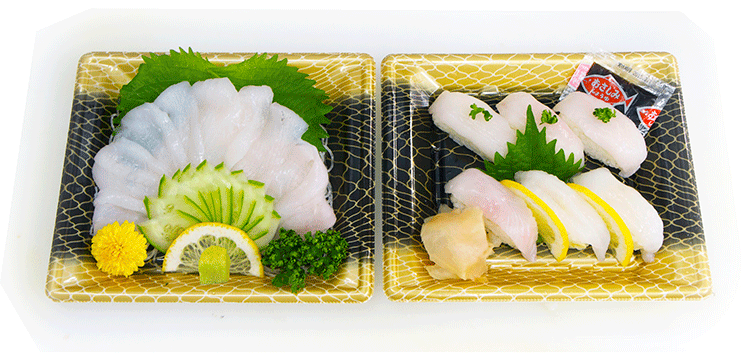

Origin of name
In Fukuoka and Nagasaki this fish(John dory)is called "Batou". The official name of the matoudai can easily be imagined from a single large round "Target of the bow" sign on the side of the fish, which is called by Matou in some areas. But why is it called Batou I have been unable to understand for so long.
However, at one time I understood that Batou refers to "head of horse" with kanji.
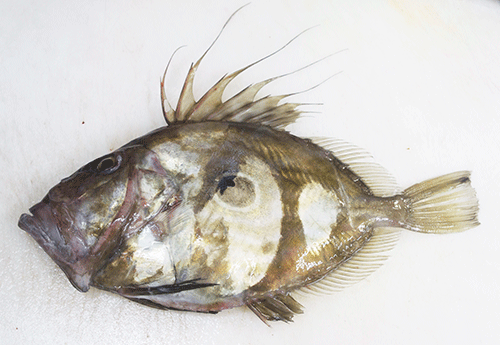
The image above is John Dory before ruin after being caught shortly before fishing, and the surface of the fish is still vertically rippled like a ripple. As time goes by, the surface will gradually turn blackish to gray, like the underlying image.
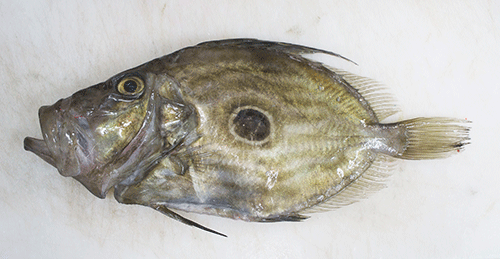
The image below adds noise to parts other than the head, in order to emphasize John Dory's head. If you look closely at the head that opens its mouth, this is certainly like "the head of a horse."
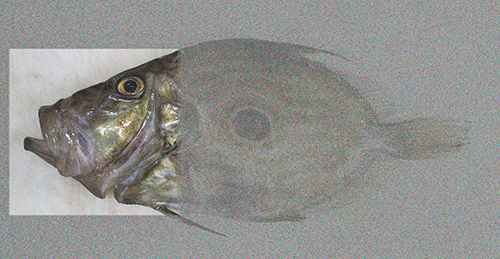
In other words, John Dory is "the sea bream of the horse's head" which is called Batou in Fukuoka. You can understand that it is not the "Target of the bow's snapper" which is focusing on the target of the bow of fish body surface in another area.
John Dory's head is characterized by a long distance between the eyes and the nose like a horse. This is related to the fact that the lower jaw is lengthened to open the mouth widely, it is a bottom raw fish inhabited near the ocean floor, so this is directed towards the prey swimming above the head of John Dory, with its mouth diagonally upward It is structured to open quickly and wide.
French luxury fish
John Dory seems to live in Europe and the Mediterranean and many others, it is called Saint-Pierre in French, pez de San Pedro in Spanish, and in other languages it is called one of the twelve Apostles in Christianity It is called by the name related to Saint Petro. St. Petro said that he took money of his contribution from John Dory's wide open mouth and that the black spots on the side of the fish are seen as the fingerprints of Saint Petro that was attached at that time.
The picture below is a small town called CHAVILLE near Versailles near Paris on Sunday, October 31, 2010, which is a photograph that I took in a market found by chance, among them Saint-Pierre Is shown.
It is like a very familiar fish in France, and the price stated on the price card of the image is 1 kg 18 euros (2,200 yen / kg in terms of Japanese yen) and this selling price is in France It can be inferred that it is one of high class fish.
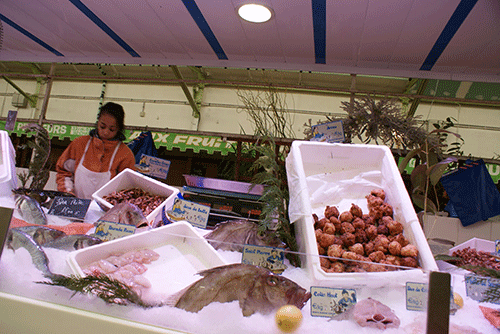

Saint Pierre
Saint-Pierre seems to be French dishes primarily to Muniel, and in France it is listed as one of the two largest Muniere materials of French cuisine along with red tonguefish.
L'Ambroisie restaurant in Paris

The above cuisine is one of the menu of L'Ambroisie, a fine restaurant in Paris "John Dory's Poiret (a dish that baked the surface of ingredients after fattening in a frying pan)".
This is the lightest fish dish in this restaurant menu, and steamed vegetables and lemon grass are added to the fillet burned lightly in a frying pan.
It is delicious even in hot pot dishes
The time of egg laying in Japan is around spring to summer, so the season will be spring from winter, and in February John Dory is the most delicious season of the year.
John Dory, which moves independently without making a flock, is not caught collectively and is often caught sporadically a little. For this reason, it is not a fish that can be mass marketed as a product of a fish shop but should be positioned as a fish that occasionally only a few are sales of plus alpha.
As a period of February, it is also suitable as a material for hot pot cooking, and it is made into a pot cooking product as follows.
| Fillets methods for pot dish of John Dory |
|---|
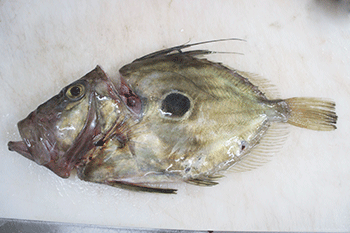 |
| 1, make a notch with a thick part of the blade of the kitchen knife on the horse's neck part. |
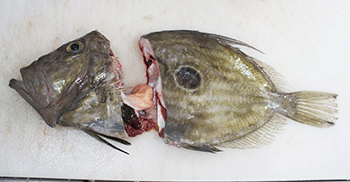 |
| 2, has a head left hand, a part of the body with the right hand, and spread to the left and right, it is separated while most of the internal organs remained in the head side. |
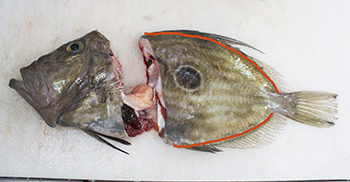 |
| 3, John Dory has sharp hard spines beside the back bire and buttocks bire. Along the red line of the image, cut off this thorns and the back bire and buttocks bire with the knife edge of the kitchen knife together. |
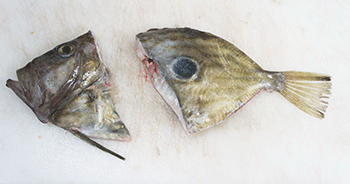 |
| 4, Remove all the internal organs remaining on the head and body with knives and brushes. |
 |
| 5, the part of the body which the head was cut off and hard and sharp thorns were removed along with fillets. |
 |
| 6, Do not disassemble into two pieces, cut the head and abdomen as evenly as possible. |
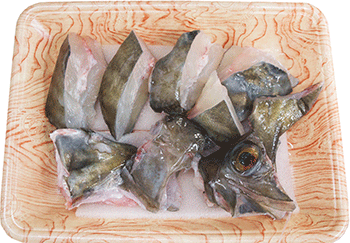 |
| Fillets for pot dish of John Dory |
Sashimi and sushi are exquisite taste
Next let's move on to the process of commercializing sashimi and sushi.
| John Dory's sashimi and sushi preparation process |
|---|
 |
| 1, Head separated for sashimi and sashimi. |
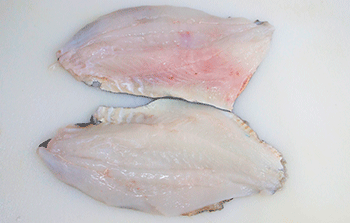 |
| 2, to dismantle in three pieces. |
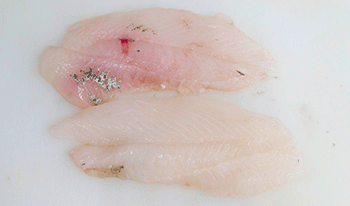 |
| 3, Remove the skin. |
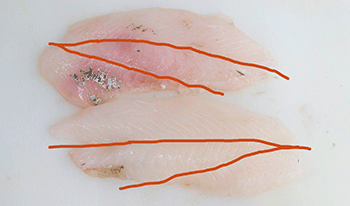 |
| 4, One of the characteristic features of John Dory is that the wider upper body is divided into two, and the half body is divided into three. |
 |
| 5, the state in which the half body is divided into three, divided into six by one fish. |
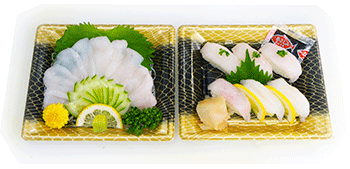 |
| Completion of commodity of top image. |
If the freshness is good, the taste is also good
The following image is John Dory outstanding in freshness that time has not elapsed since it was caught.

When this is disassembled into three pieces and the skin is removed, one fish is divided into six pieces. When the freshness is good, it is a color close to skin color.
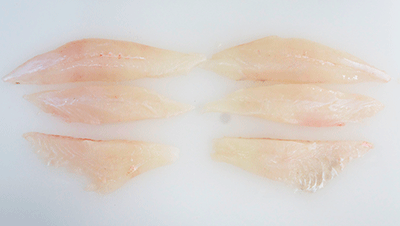
If you make this sashimi, it will be like the following items.

In this way, I think you can understand that the color of the skin color of the above image is more than the color of the top image. In other words, John Dory gradually becomes whitish as time passes.
Basically, this fish is a candid taste, but the umami taste does not instantaneously but it has a deliciousness that gradually comes out little by little, and it can be said that it is a fish of a genius preference whose true taste of natural fish is known.
The world proves that it is best as Western style dishes such as Muniel, but the present season is delicious even in hot pot dishes and fish with good freshness is nevertheless a fish of a level that is inferior to Japanese flounder.
It can not be said that it looks very good-looking fish, and the ratio of the edible portion is small and it can not be said that cost performance is high and it is not even a fish that you can easily get anytime you want to eat this fish.
If John Dory with good freshness is lined up in the market during this season, it should be purchased and commercialized without hesitation. And it is not necessarily high profile, I would like you to be pleased to tell the customer about the taste of this fish and how to cook.
<After uploading, sentences added quickly>
Regarding the ripple pattern of John Dory above, at 11 o'clock on 1st February, a reader sent me an email with interesting information on John Dory. According to the point of view on a private basis, omit a part of the sentence in a form that individuals can not identify, let's introduce the contents below.
<First part omitted> I am looking forward to seeing you every month. This month's John dory is my favorite fish. |
|---|
Although I do not have direct contact with the person who got this mail, it is the first e-mail for 1 year and 3 months since I interacted in November 2015 on the "Fishery primer" purchase. I would like to express my appreciation to you for being extremely careful not to hurt my ignorance, because I am made to feel a very gentlemanlike personality from that sentence.
In other words, judging from the above pointed out contents, this freshness preeminent John Dory is that something was in contact with the fish body, and the part in contact was discolored white.
I knew that flounder assimilates the surface of the fish like the chameleon, but John Dory, the same bottom fish as the flounder, can certainly change the pattern of the fish in the same way It should be effective for capture of food.
I have plenty of things that I do not know much about fish, and this kind of indication is really appreciated.
For other readers, if you have an opinion, I would like to email the following contacts.
An opinion and the communication are to iinfo@fish food times
Date of updating Feb1, 2017
